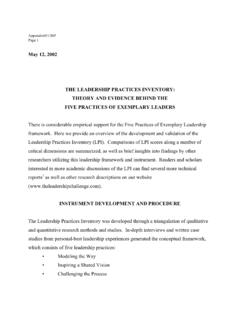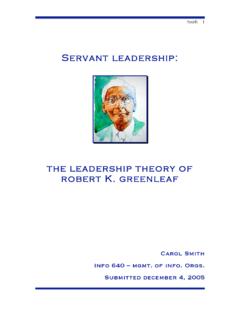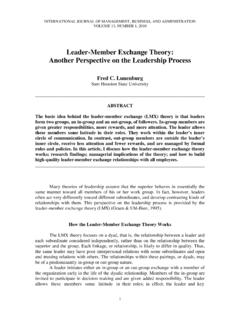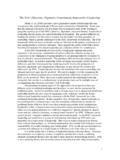Transcription of The Transformational Leadership Report
1 The Transformational Leadership Report Developing Tomorrow s Transformational Leaders Today "The goal of Transformational Leadership is to transform people and organizations in a literal sense to change them in mind and heart; enlarge vision, insight, and understanding; clarify purposes; make behavior congruent with beliefs, principles, or values; and bring about changes that are permanent, self-perpetuating, and momentum building." - Steven Covey, Author of 7 Habits of Highly Successful People - The Transformational Leadership Report 2007 2 of 19 INDEX What is Transformational Leadership ? 3 Components of Transformational Leadership 5 Transformational Leadership vs.
2 Transactional Leadership 6 A Brief History of Leadership 8 How does a Transformational Leader work? 10 What are the characteristics of a leader of change? 10 Where Transformational Leadership and Authenticity meet 11 Transformational Leadership Behaviors 13 Recommended Reading 17 TL Publications list 19 The Transformational Leadership Report 2007 3 of 19 What is Transformational Leadership ? Leadership has been around for thousands of years, and yet we still are unable to contain it in a single definition we all agree on. Perhaps this is because Leadership is continuously evolving, and more than what it seems to be, depending on how you look at it.
3 It is a complex concept, with many applications, and the results that it creates depend highly on the context in which it is being observed. Much has been written on Transformational Leadership , which we will cover in a moment. There is the Leadership theory, which has evolved over time from other Leadership styles, and has applications to different contexts, be it in business, medical, non-profit or charity, education, religious or spiritual groups and even at the family level, to name a few. Ask anyone you know for a definition of a word, and they will give you their version, the version that makes the most sense to them. The same would apply to Transformational Leadership .
4 It depends on who you speak to, and what their perspective is. We ll consider two main points of view: - the theoretical, and - the applied Theoretical definitions come from those that study Leadership , who have the formal qualifications to write long dissertations on the subject. This body of knowledge is fantastic for grounding in the subject and to get into the depth of the potential implications, especially when it comes to the morals and ethics department. The applied is the interpretation, and then applied action in a specific field of endeavor. We ll use the personal, organizational, and global contexts for this purpose. You will have your own applied experience, or not, depending on where you are on your own personal Transformational Leadership journey.
5 With that in mind, we ll first take a look at where the origins of the subject come The Transformational Leadership Report 2007 4 of 19 The term Transformational Leadership was first coined by Downton in Rebel Leadership : Commitment and Charisma in a Revolutionary Process (1973). James MacGregor Burns first introduced the concept of Transformational Leadership in his book Leadership (1978), during his study of political Leadership , but this term is now used in organizational psychology as well. He described it not as a set of specific behaviors, but rather an ongoing process by which "leaders and followers raise one another to higher levels of morality and motivation" (p.)
6 20). Transformational leaders offer a purpose that transcends short-term goals and focuses on higher order intrinsic needs. Transformational leaders raise the bar by appealing to higher ideals and values of followers. In doing so, they may model the values themselves and use charismatic methods to attract people to the values and to the leader. Burns was influenced by Abraham Maslow s Theory of Human Needs. This theory recognizes that people have a range of needs, and the extent to which they will perform effectively in the workplace will be affected by the extent to which these needs are satisfied. Transformational Leadership fits into the higher levels, as it requires a high level of self esteem and self actualization to successfully be an authentic Transformational leader.
7 It s about values, purpose and meaning: Essentially the leader s task is consciousness-raising on a wide plane..The leader s fundamental act is to induce people to be aware or conscious of what they feel -- to feel their true needs so strongly, to define their values so meaningfully, that they can be moved to purposeful action. ( Leadership , pp 43-44) Burns was one of the first scholars to assert that true Leadership not only creates change and achieves goals within the environment, but changes the people involved in the necessary actions for the better as well: both followers and leaders are ennobled. Burns became famous among alternative Leadership scholars because his model of Transformational Leadership included an ethical/moral dimension that, prior to 1978, had not been infused into any Leadership theory Bernard Bass, a disciple of Burns, defined Transformational Leadership in terms of how the leader affects followers, who are intended to trust, admire and respect the Transformational leader.
8 He identified three ways in which leaders transform followers: Increasing their awareness of task importance and value. Getting them to focus first on team or organizational goals, rather than their own interests. Activating their higher-order needs. In contrast to Burns, who sees Transformational Leadership as being inextricably linked with higher order values, Bass sees it as amoral, and therefore questions the morality and ethical component of Transformational Leadership . The Transformational Leadership Report 2007 5 of 19 Components of Transformational Leadership Transformational Leadership has evolved from and contains elements of preceding Leadership types, such as trait and behaviour theories, charismatic, situational and transactional Leadership .
9 There are four components of Transformational Leadership , which are: Charisma or idealized influence This is the degree to which the leader behaves in admirable ways that cause followers to identify with the leader. Charismatic leaders display convictions, take stands and appeal to followers on an emotional level. This is about the leader having a clear set of values and demonstrating them in every action, providing a role model for their followers. Genuine trust must be built between leaders and followers. Trust for both leader and follower is built on a solid moral and ethical foundation. Inspirational motivation The degree to which the leader articulates a vision that is appealing and inspiring to followers.
10 Leaders with inspirational motivation challenge followers with high standards, communicate optimism about future goals, and provide meaning for the task at hand. Followers need to have a strong sense of purpose if they are to be motivated to act. It is also important that this visionary aspect of Leadership be supported by communication skills that allow the leader to articulate his or her vision with precision and power in a compelling and persuasive way. Intellectual stimulation The degree to which the leader challenges assumptions, takes risks and solicits followers' ideas. Leaders with this trait stimulate and encourage creativity in their followers. The leader s vision provides the framework for followers to see how they connect to the leader, the organization, each other, and the goal.







